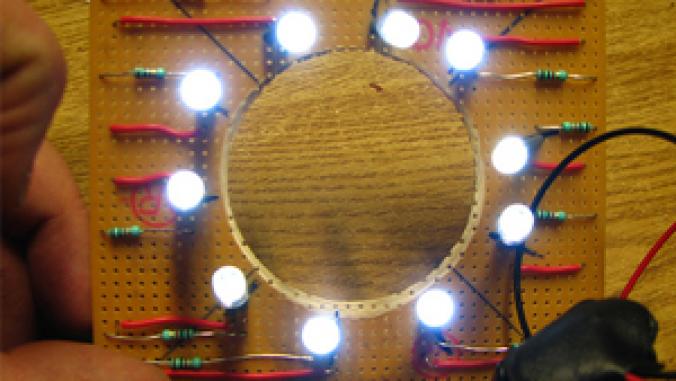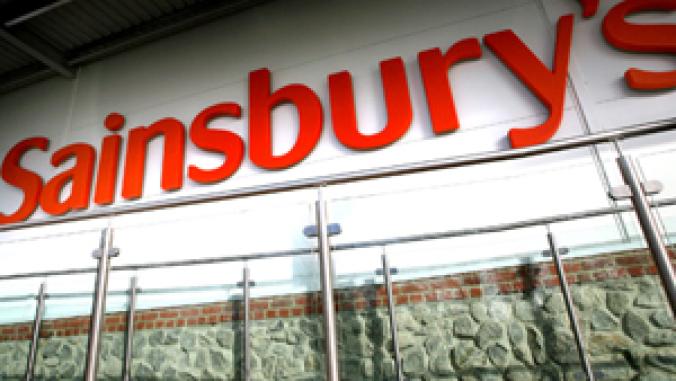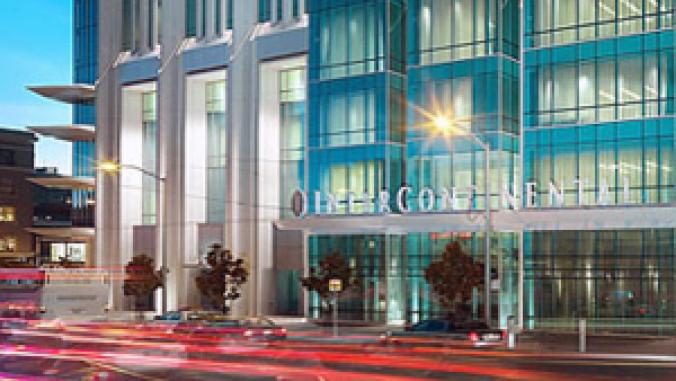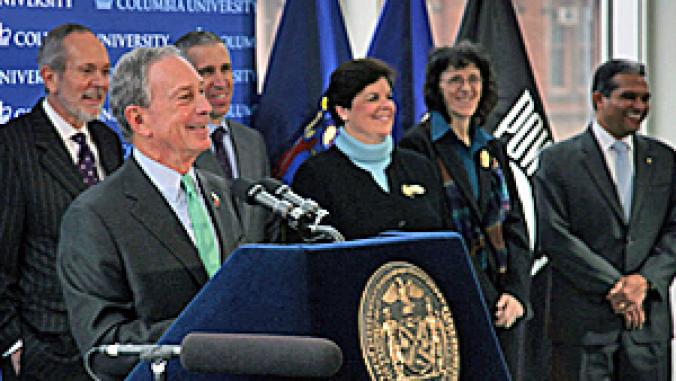Casting a Long Shadow
One of Manhattan's great family-owned commercial development firm is greening the city's skyline, making environmentally intelligent building strategies a competitive requirement. By Phil Storey
One of the best-known landmarks of Times Square was installed in 1989: the National Debt Clock. The billboard-sized display shows passers-by the fast-growing national debt total, as well as "your family share." Seymour Durst, second-generation leader of the family real estate business known as the Durst Organization, installed the Debt Clock to point out that, in his words, "We have mortgaged our future and the future of our country because we refuse to face our fiscal responsibilities."
The Debt Clock was retired in 2000, when the federal government began paying down the national debt and the clock started running backwards (creating puzzlement more than awareness). But in July 2002, with the return of large federal budget deficits, Durst Organization co-presidents Douglas and Jonathan (Jody) Durst (Seymour's son and nephew, respectively) restarted the Debt Clock.
The mindfulness symbolized by the National Debt Clock is very much a part of how the Durst family of developers does business. The family's real estate legacy began in 1915 when Joseph Durst, the grandfather of Douglas and Jody, purchased an office building on 34th Street in Manhattan. In the decades that followed, the Durst Organization grew its holdings, eventually focused on commercial properties, and built a reputation for prudent management, stability and exceptional responsiveness to its tenants.
Greening the Skyline
During the past few years, in addition to managing its current properties, the Durst Organization has been leading the greening of New York City's skyline. The company's environmental leadership has been recognized by awards from the Natural Resources Defense Council (Forces for Nature Award, 2001), U.S. Environmental Protection Agency (Region 2 Environmental Quality Award, 2004) and Global Green (Design Award, 2004), among others.
The Durst Organization made its first big environmental splash in the mid 1990s, when they developed the first green-designed skyscraper in the United States: Four Times Square. The 48-story, 1.6-million-square-foot building was designed by Fox & Fowle Architects and built by Tishman Construction Corporation, and opened its doors in 2000. From its very inception, Four Times Square was an icon of environmentally intelligent design, with abundant fresh air and daylight throughout the building, fuel cells and photovoltaic (solar-energy-generating) panels, variable-speed drives for the pumps and fans, occupancy sensors and efficient lighting systems.
Success was far from obvious at the outset. It was the first commercial high-rise built in Midtown Manhattan in a decade. The $500-million project was speculative when the Durst Organization announced it in August 1996, with no "anchor tenant" lined up in advance. (Condé Nast quickly filled that role.) Then construction was marred by two fires and a scaffolding collapse. But the building has been a success, with satisfied tenants and high occupancy rates.
One of the original tenants is Innovest Strategic Value Advisors, an independent research firm specializing in non-traditional sources of investment risk and performance, including environmental and social factors. So moving into Four Times Square -- and outfitting it with environmentally superior interior design and furnishings -- was important to the company. "We wanted to walk the talk," says Hewson Baltzell, president of Innovest. And they've been pleased with the results. "People like the space. They like working here."
Advanced environmental design strategies are now part of all new Durst Organization projects. On Manhattan's west side, the Dursts are building a 37-story, 580-unit residential tower called the Helena, scheduled for completion later this year. The building was designed by Fox & Fowle, the architects of Four Times Square, to achieve a Leadership in Energy and Environmental Design (LEED) Gold rating from the US Green Building Council. The Helena's sustainable design features include photovoltaic panels, on-site wastewater treatment and reuse, plant-covered roofs to manage storm water and provide insulation, an efficient micro-turbine co-generation energy system, and the use of renewable materials such as bamboo and certified wood.
The few Durst activities outside Manhattan address ecological sustainability in a rural environment. The Durst Organization is developing a 975-home community and country club in Dutchess County, about 100 miles north of New York City, called the Hudson Valley Club. While the project is still in the planning and approval stage, the Durst Organization has hired the Rocky Mountain Institute's Green Development Services to advise the developers on issues of habitat, storm water, wastewater treatment and green building. And just a few miles away is New York state's largest organic farm, 500-acre McEnroe Organic Farm, which Douglas Durst has co-owned since 1987.
A New Icon
The Durst Organization's latest project, the Bank of America Tower at One Bryant Park, is by far its most ambitious, and raises the bar once again for high-rise commercial development. The project broke ground last year and is expected to open for occupancy in 2008. It is a 54-story crystalline structure designed by Cook+Fox Architects, on the same block as Four Times Square and overlooking both Times Square and Bryant Park. As the next generation of intelligent high-rise design, One Bryant Park includes a dazzling array of cutting-edge environmental features and strategies -- the building will clean the air, treat and reuse storm water, and generate its energy on-site with an efficient CO-generation plant, among other things. (See inset, One Bryant Park.)
In addition to its environmental innovations, One Bryant Park will be a visual icon in the Midtown skyline. The design was inspired by elements of New York City's classic skyscrapers and by the New York Crystal Palace, the first glass-and-iron building in America, erected in Bryant Park in 1853. One Bryant Park's crystalline form spirals from its base to its highest tower, with glass curtain walls forming sculptural facets animated throughout the day and night by the movements of the sun and moon. And at the street level, the building engages with the pedestrian and traffic patterns of Times Square, offering attractive and convenient public spaces.
Constructing a Legacy
So what does all this add up to in New York City's cultural and commercial hotbed? Despite the Dursts' disappointment that Four Times Square was not emulated immediately, Manhattan's high-profile new development projects are now going green. (The Freedom Tower designed for the World Trade Center, new headquarters for both The New York Times and the Hearst Corporation, and Seven World Trade Center all have environmental design elements and LEED aspirations.) Architectural Record gives the Durst Organization much of the credit for this trend. It was the pioneering Four Times Square project, quickly followed by the US Green Building Council's release of LEED and the establishment of environmental guidelines for residential construction in lower Manhattan's Battery Park City, that convinced other developers to follow. According to one developer quoted in Architectural Record, "Before that, we said, 'Why bother?' No one understood green design of what its advantages were. But after Four Times Square, everyone thought, 'We can do that too.'"
Leading by example is exactly what the Dursts want to do, according to architect Bob Fox, whose work with the Dursts has included Four Times Square and the Helena as principal of Fox & Fowle, and One Bryant Park as principal of Cook+Fox. For the Dursts, Fox says, "this is about sharing and learning and allowing others to learn from what the Dursts spent a lot of money doing research on. They'd like other people to say, 'Hey, this is pretty good. Let me do it too.'" And now (finally) many of the Dursts' peers are doing it too.
--------
This article has been reprinted courtesy of green@work. It first appeared in the Summer 2005 edition of that publication.
One of the best-known landmarks of Times Square was installed in 1989: the National Debt Clock. The billboard-sized display shows passers-by the fast-growing national debt total, as well as "your family share." Seymour Durst, second-generation leader of the family real estate business known as the Durst Organization, installed the Debt Clock to point out that, in his words, "We have mortgaged our future and the future of our country because we refuse to face our fiscal responsibilities."
The Debt Clock was retired in 2000, when the federal government began paying down the national debt and the clock started running backwards (creating puzzlement more than awareness). But in July 2002, with the return of large federal budget deficits, Durst Organization co-presidents Douglas and Jonathan (Jody) Durst (Seymour's son and nephew, respectively) restarted the Debt Clock.
The mindfulness symbolized by the National Debt Clock is very much a part of how the Durst family of developers does business. The family's real estate legacy began in 1915 when Joseph Durst, the grandfather of Douglas and Jody, purchased an office building on 34th Street in Manhattan. In the decades that followed, the Durst Organization grew its holdings, eventually focused on commercial properties, and built a reputation for prudent management, stability and exceptional responsiveness to its tenants.
Greening the Skyline
During the past few years, in addition to managing its current properties, the Durst Organization has been leading the greening of New York City's skyline. The company's environmental leadership has been recognized by awards from the Natural Resources Defense Council (Forces for Nature Award, 2001), U.S. Environmental Protection Agency (Region 2 Environmental Quality Award, 2004) and Global Green (Design Award, 2004), among others.
The Durst Organization made its first big environmental splash in the mid 1990s, when they developed the first green-designed skyscraper in the United States: Four Times Square. The 48-story, 1.6-million-square-foot building was designed by Fox & Fowle Architects and built by Tishman Construction Corporation, and opened its doors in 2000. From its very inception, Four Times Square was an icon of environmentally intelligent design, with abundant fresh air and daylight throughout the building, fuel cells and photovoltaic (solar-energy-generating) panels, variable-speed drives for the pumps and fans, occupancy sensors and efficient lighting systems.
Success was far from obvious at the outset. It was the first commercial high-rise built in Midtown Manhattan in a decade. The $500-million project was speculative when the Durst Organization announced it in August 1996, with no "anchor tenant" lined up in advance. (Condé Nast quickly filled that role.) Then construction was marred by two fires and a scaffolding collapse. But the building has been a success, with satisfied tenants and high occupancy rates.
One of the original tenants is Innovest Strategic Value Advisors, an independent research firm specializing in non-traditional sources of investment risk and performance, including environmental and social factors. So moving into Four Times Square -- and outfitting it with environmentally superior interior design and furnishings -- was important to the company. "We wanted to walk the talk," says Hewson Baltzell, president of Innovest. And they've been pleased with the results. "People like the space. They like working here."
Advanced environmental design strategies are now part of all new Durst Organization projects. On Manhattan's west side, the Dursts are building a 37-story, 580-unit residential tower called the Helena, scheduled for completion later this year. The building was designed by Fox & Fowle, the architects of Four Times Square, to achieve a Leadership in Energy and Environmental Design (LEED) Gold rating from the US Green Building Council. The Helena's sustainable design features include photovoltaic panels, on-site wastewater treatment and reuse, plant-covered roofs to manage storm water and provide insulation, an efficient micro-turbine co-generation energy system, and the use of renewable materials such as bamboo and certified wood.
The few Durst activities outside Manhattan address ecological sustainability in a rural environment. The Durst Organization is developing a 975-home community and country club in Dutchess County, about 100 miles north of New York City, called the Hudson Valley Club. While the project is still in the planning and approval stage, the Durst Organization has hired the Rocky Mountain Institute's Green Development Services to advise the developers on issues of habitat, storm water, wastewater treatment and green building. And just a few miles away is New York state's largest organic farm, 500-acre McEnroe Organic Farm, which Douglas Durst has co-owned since 1987.
A New Icon
The Durst Organization's latest project, the Bank of America Tower at One Bryant Park, is by far its most ambitious, and raises the bar once again for high-rise commercial development. The project broke ground last year and is expected to open for occupancy in 2008. It is a 54-story crystalline structure designed by Cook+Fox Architects, on the same block as Four Times Square and overlooking both Times Square and Bryant Park. As the next generation of intelligent high-rise design, One Bryant Park includes a dazzling array of cutting-edge environmental features and strategies -- the building will clean the air, treat and reuse storm water, and generate its energy on-site with an efficient CO-generation plant, among other things. (See inset, One Bryant Park.)
In addition to its environmental innovations, One Bryant Park will be a visual icon in the Midtown skyline. The design was inspired by elements of New York City's classic skyscrapers and by the New York Crystal Palace, the first glass-and-iron building in America, erected in Bryant Park in 1853. One Bryant Park's crystalline form spirals from its base to its highest tower, with glass curtain walls forming sculptural facets animated throughout the day and night by the movements of the sun and moon. And at the street level, the building engages with the pedestrian and traffic patterns of Times Square, offering attractive and convenient public spaces.
Constructing a Legacy
So what does all this add up to in New York City's cultural and commercial hotbed? Despite the Dursts' disappointment that Four Times Square was not emulated immediately, Manhattan's high-profile new development projects are now going green. (The Freedom Tower designed for the World Trade Center, new headquarters for both The New York Times and the Hearst Corporation, and Seven World Trade Center all have environmental design elements and LEED aspirations.) Architectural Record gives the Durst Organization much of the credit for this trend. It was the pioneering Four Times Square project, quickly followed by the US Green Building Council's release of LEED and the establishment of environmental guidelines for residential construction in lower Manhattan's Battery Park City, that convinced other developers to follow. According to one developer quoted in Architectural Record, "Before that, we said, 'Why bother?' No one understood green design of what its advantages were. But after Four Times Square, everyone thought, 'We can do that too.'"
Leading by example is exactly what the Dursts want to do, according to architect Bob Fox, whose work with the Dursts has included Four Times Square and the Helena as principal of Fox & Fowle, and One Bryant Park as principal of Cook+Fox. For the Dursts, Fox says, "this is about sharing and learning and allowing others to learn from what the Dursts spent a lot of money doing research on. They'd like other people to say, 'Hey, this is pretty good. Let me do it too.'" And now (finally) many of the Dursts' peers are doing it too.
--------
This article has been reprinted courtesy of green@work. It first appeared in the Summer 2005 edition of that publication.




